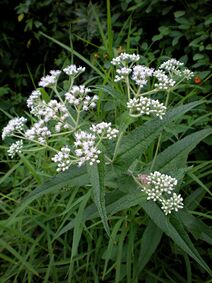Eupatorium perfoliatum
| Eupatorium perfoliatum | |
 | |
| Light: | |
| Moisture: | |
| Soil pH: | 5.6-8.4 |
| Self Pollinated | |
| Height: | 4' |
| Blooms: | Mid Summer-Early Fall |
| Native to: | |
| Nectary | |
| Medicinal Rating: | |
| Tea: | Yes |
Eupatorium perfoliatum (common name: thoroughwort and boneset)
Blossoms of snow bloom late-season and grow tall with small florets and white petals making clean breaks above its leaves in partially shady and bright patches. Highly-accessible nectar attracts many Lepidoptera butterflies while bitter foliage deter pests. Perfect for rain gardens, Boneset thrives in moist and organic-rich soil. Introduced to the colonists by indigenous Americans for Dengue fever, cold, and flu treatments, this medicinal perennial was also thought to aid broken bones and had its leaves incorporated into splint bandages. This belief stemmed from the distinctive fused leaves that appear pierced by cylindrical stalks, while no longer used to set bones, this unique shape gave rise to the species name perfoliatum—to pierce. Still, this herbaceous herb has a rich medical past as showcased its other names to include agueweed and feverwort. The flower is easily propagated by seed and can be trimmed in early Spring to promote bushier growth.
Propagation: Seed - sow spring in a cold frame and only just cover the seed. Prick out the seedlings into individual pots when they are large enough to handle and plant them out into their permanent positions in the summer.
Division in spring or autumn[1]. Very easy, the clumps can be replanted direct into their permanent positions.
Cultivation: Succeeds in ordinary well-drained but moisture retentive garden soil in sun or part shade[2].
A very cold-hardy plant, tolerating temperatures down to about -25°c[3].
Plants seem to be immune to the predations of rabbits[4].
A polymorphic species[5].
Range: Eastern N. America - Quebec to Manitoba, south to Florida and Texas.
Habitat: Wet woods, scrub, fens and damp grassland[3]. Sandy soils in Texas[6].
Medicinal: Thoroughwort is one of the most popular domestic medicines in North America[5][7] where it is used in the treatment of influenza, colds, acute bronchitis, catarrh and skin diseases[8]. It has been shown to stimulate resistance to viral and bacterial infections, and reduces fevers by encouraging sweating[9]. The plant, however, should be used with some caution since large doses are laxative and emetic and the plant might contain potentially liver-harming pyrrolizidine alkaloids[10].
The leaves and flowering stems are antispasmodic, cholagogue, diaphoretic, emetic, febrifuge, laxative, purgative, stimulant, vasodilator[5][11][12][8]. A hot infusion of the dried leaves and flowers is used as a very effective treatment to bring relief to symptoms of the common cold and other similar feverishness - it loosens phlegm and promotes its removal through coughing[7][9][13]. This herb is practically unequalled in its effectiveness against colds[13]. It is also used in the treatment of rheumatic illness, skin conditions and worms[9]. The leaves and flowering stems are harvested in the summer before the buds open, and are dried for later use[8].
A homeopathic remedy is made from the fresh plant, harvested when it first comes into flower[14]. It is used in the treatment of illnesses such as flu and fever[14].
Pollinators: Insects
Soil: Can grow in light, medium, and heavy soils.
Drainage: Prefers well drained soil.
Flower Type: Hermaphrodite
Links
- Eupatorium perfoliatum - Plants for a Future
- Eupatorium perfoliatum - USDA Plant Profile
References
- ↑ Sanders, Thomas. Popular Hardy Perennials. Collingridge, 1926.
- ↑ Huxley, Anthony. The New Royal Horticultural Society Dictionary of Gardening. MacMillan Press, 1992.
- ↑ 3.0 3.1 Phillips, Roger and Martyn Rix. Perennials - The Definitve Reference. Pan Books, 1991.
- ↑ Thomas, Graham. Perennial Garden Plants. J. M. Dent & Sons, 1990.
- ↑ 5.0 5.1 5.2 Grieve, Margaret. A Modern Herbal. Penguin, 1984.
- ↑ Diggs, George and Barney Lipscomb. Illustrated Flora of North Central Texas. Botanical Research Institute, 1999.
- ↑ 7.0 7.1 Weiner, Michael. Earth Medicine, Earth Food. Ballantine Books, 1980.
- ↑ 8.0 8.1 8.2 Bown, Deni. Royal Horticultural Society Encyclopaedia of Herbs and Their Uses. Dorling Kindersley, 1995.
- ↑ 9.0 9.1 9.2 Chevallier, Andrew. The Encyclopedia of Medicinal Plants. Dorling Kindersley, 1996.
- ↑ Foster, Steven and Billy Tatum. Medicinal Plants of Eastern and Central North America. Houghton Mifflin, 1990.
- ↑ Usher, George. A Dictionary of Plants Used by Man. Constable, 1974.
- ↑ Mills, Simon. The Dictionary of Modern Herbalism.
- ↑ 13.0 13.1 Stuart, Malcolm. The Encyclopedia of Herbs and Herbalism. Orbis Publishing, 1979.
- ↑ 14.0 14.1 Castro, Miranda. The Complete Homeopathy Handbook. Macmillan, 1990.